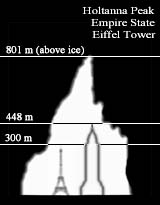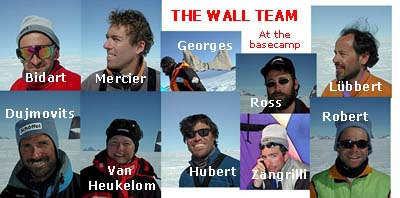DISPATCHE
11 : from 26 to 31 January

Wednesday
31 January : The children have asked some questions (pertinent as
is always the case) and the climbers have answered...
|
Alain
Hubert and René Robert have just left the South African Sanae
base camp on skis, having arrived there by DC3 the day before
yesterday.

They
now have to get to the German base Neumayer, where the Polarstern
(Pole Star) should be arriving on about 06 February before taking
them to Punta Arenas. There are about 220 km between Sanae and
Neumayer.
This
journey has to be made over an ice shelf that is riddled with
crevasses, and as at yesterday (Tuesday 30 January), Alain and
René were expecting difficult weather conditions (storm warning).
|
While
waiting for the men to return, here are some of the questions asked
by the children whose classes are enrolled in the Educational Project.
Q
: Why did the last four metres of the ascent take so long?
R : Because during the ascent, each climber had a task to accomplish,
sometimes at different heights on the wall. This took time so that
in the end they could all get together and finish the summit together.
Q
: What is a portaledge? What is it for?
R : It's a sort of tent than can be attached to the rock face. Composed
of a closed canvas bed, it is fixed to the rock by a single suspension
point. Mountaineers can sleep in them and shelter from storms. They
can be single or double.
Q
: What are your protection accessories? Which part of the body do
they protect?
R : Climbers have only one real protection accessory, which is a helmet
for the head.
Q
: We have not understood certain words, like kata, spit and skidoo.
Could you please explain them?
R : The kata is a Nepalese or Tibetan scarf, blessed by the Buddhist
monks from a monastery. This scarf is thought to ensure "God speed"
for the traveller to whom it is given. It should then be left at a
place where the wind blows so that the blessing can be dispersed for
the benefit of all. This is why Alain left one at the Holtanna summit.
A spit is a large screw and an attachment for a rope. On the rock
face, every 50 metres or in dangerous places, mountaineers use them
to provide powerful insurance that they will not come off. They make
a hole in the rock with a hand-powered drill, then insert the spit,
which they then block with the bolt. It is very strong, and as they
climb they can fix a rope to the attachment point that will hold it
perfectly. The skidoo is a motorbike on skis, and is used for travelling
over snow. It is very practical, and allows heavy loads to be quickly
transported, sometimes over long distances. When it is exceptionally
cold, ignition can at times be a bit slow to catch in the morning.
There are two skidoos at Blue One. I would also like to explain what
a cairn is. This is made up of stones that have been piled on top
of each other to make a small monument to show that one has gone this
way, whether at the top of a mountain or on a barely trodden path.
Q
: What work did NASA entrust to you?
R : NASA entrusted us with the mission of looking for new species
of lichen, but above all of installing electronic thermometers for
year-long measurement of the temperature of the rock on which it grows
This information is of interest to NASA because, during the hottest
period of the year on the planet Mars, the climatic condition at times
resemble those of the Antarctic winter. So scientists are trying to
understand, with the help of lichen, how life could have existed on
Mars. The radio and satellite communication technology of the automatic
weather stations that we have installed will also perhaps be used
one day in a meteorological programme on Mars.
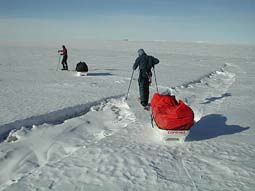 Q
: Why do you dig wells? What are you looking for? How deep are they?
Q
: Why do you dig wells? What are you looking for? How deep are they?
R : We have dug wells that are between 1.5 and 2 metres deep to conduct
some glaciological studies. Snow accumulates over the years, so we
find layers in the wells that are sometimes more than ten years old
and study them to learn how they have evolved, what their temperature
is, and their density. We carried out this work during the expedition
so that scientists could know the characteristics of the snow solely
from satellite pictures.
Q
: Why were you photographing grains of snow?
R : In the context of the glaciological research, we took photographs
to know the size and shape of the grains of snow at various depths
of the well, which is a way of transmitting the information to the
scientists in the laboratories at a later date.
Q
: How do you know that there could be meteorites at the place you
spotted from the summit? Did you see a crater? Or a pebble?
R : The regions where we have the best chance of finding meteorites
are the fields of blue ice, for in these areas the ice comes up from
the bottom of the polar icecap and brings with it all the meteorites
that have fallen into the snow over tens of thousands of years It
was an interesting area of blue ice that the climbers saw from the
summit, unfortunately too far away for quick access on skis.
Q
: If you find a meteorite, could you please send us a photograph?
R : Yes, with pleasure, but unfortunately we didn't find one.
Q
: What do you do doing your spare time?
R : We sleep, we read, we write, we get together to for a laugh and
a joke, and we eat lovely meals.
Q
: How do you have the courage to sleep in sleeping bags at altitude?
Are you never frightened of sleeping on the rock face?
R : It's like with life, initially you have no experience, it's not
reassuring, you are frightened of falling, then you get used to the
emptiness, your realise that the assembly where you are sleeping is
sound, and you become reassured that everything will be OK.
Q
: What do you do to prevent yourself from falling in your sleep?
R : Climbers sleep in their sleeping bags, attached in their harnesses
by rope to the rock. So they can't fall.
Q
: How was the aeroplane able to land on the ice?
R : The Illyushin pilots are very skilful, and for them landing on
ice is much the same as landing on a tarmac or concrete runway.
Q
: How to you put the pitons in the rock when you are climbing?
R : Mountaineers can always find a crack, and in it they pick the
place where it joins up again and force the piton in with a hammer.
A rope can then be attached to it by means of a snap link.
Q
: Do you miss your families?
R : Yes, of course, we are impatient to see our families again, and
we all hope that the homecoming will live up to our expectations.
Q
: Do you communicate with your children?
R : For my part, I don't have any (Ed. Note: It is Alain Bidart who
is answering), but the members of the team that do communicate regularly
with them by e-mail.
Q
: How many time a week do you change your clothes?
R : We don't in fact wash our clothes, so we have several changes
that we put on again regularly without their really being clean. In
the Antarctic, the weather is cold and often dry, so we sweat less
than in other parts of the world and consequently we soil our clothes
less. Nevertheless, the first thing we'll be doing when we get to
South Africa is having a good shower!
Q
: Have you climbed other summits? If so, which ones?
R : After Holtanna, André and Alain "did" all the mountains around
us, about ten, nearly all of which had never been climbed before.
Q
: Did you do all this for fame or pleasure? 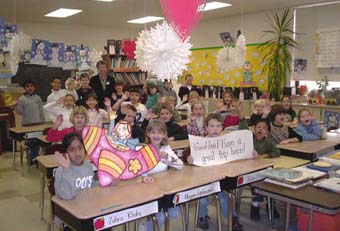
R : Above all, we did all this for love of the Antarctic and its extraordinary
environment.
Q
: Did you encounter any strange animals?
R : No, but we did encounter some fabulous snow petrels and some impressive
skuas.
Q
: Did anybody fall during the ascent?
R : Fortunately not.
Q
: Have you gone on any other expeditions before this one for physical
training?
R : Mountaineers are in fact guides and go on expeditions everywhere
in the world throughout the year, so they have all the physical training
they need.
Q
: Was the South Face of Holtanna as vertical as the North?
R : Yes, the South Face was more vertical than the North Face, at
times even overhanging.

Friday
26 January : Some leave, others climb on...
Last
Wednesday, Alain, Ronald and René left the base camp at about noon
to head for Blue One by sail. They should reach the station this evening
or tomorrow. From there, as has already been written, they will be
going first to Sanae and then on to the German base Neumayer in order
to board the Polarstern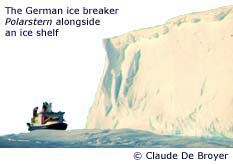 .
It is envisaged that there will be regular radio contact between this
group and the others, then with HQ.
.
It is envisaged that there will be regular radio contact between this
group and the others, then with HQ.
Meanwhile,
the others who have stayed at the base camp cannot resist climbing,
as the environment is so ideal for such activity. Just before setting
off, on Tuesday, Hubert and Georges "did" a final summit, Kintanna,
one of the most impressive summits after Holtanna and Ulvetanna.
Indeed,
speaking of this last summit, Ulvetanna, the veritable private preserve
of the Norwegian climbers and not yet climbed by the climbers of The
Wall expedition, André and Fabrizio decided at the last moment to
make an assault on it as well. So yesterday, Thursday, everybody accompanied
the two climbers as far as the foot of this giant, skiing in deep
snow. This delighted Kathelijne, who 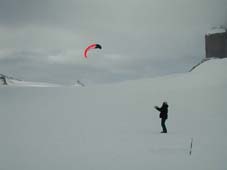 at
last had the chance of extracting herself from the preoccupations
of communicating with the outside world and of treating herself to
a little outing plumb in the middle of this magnificent scenery. In
principle, André and Fabrizio should be taking care of the giant today.
at
last had the chance of extracting herself from the preoccupations
of communicating with the outside world and of treating herself to
a little outing plumb in the middle of this magnificent scenery. In
principle, André and Fabrizio should be taking care of the giant today.
As
for the return of the people who have stayed on at the base camp (Kathelijne
Van Heukelom, André Georges, Fabrizio Zangrili and Alain Bidart, seen
here in the photograph), here is the information as sent by Kathelijne
today, Friday, (this message of course being primarily intended for
their families).
31
January: Closing (striking) the base camp and setting out with skis
and sledges for Blue One. The Illyushin 76 which should be coming
to pick them up is scheduled for 09 February, whereas the Cape Town
- Brussels flight for its part has been booked for the 13th of the
same month. 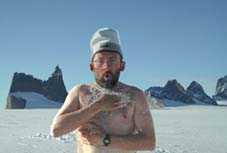
Despite the ample margins allowed by this programme, it is clear that,
given the moods of the Antarctic weather, especially at the end of
the summer season, the dates mentioned above may change from one moment
to the next. We will try our hardest, however, to keep the families
abreast of any future developments.
On
Monday, we will provide our visitors with an initial assessment of
the Educational Project, which, according to Laurent Dubois, who is
co-ordinating all the schools in Switzerland, has enjoyed a right
royal success.



